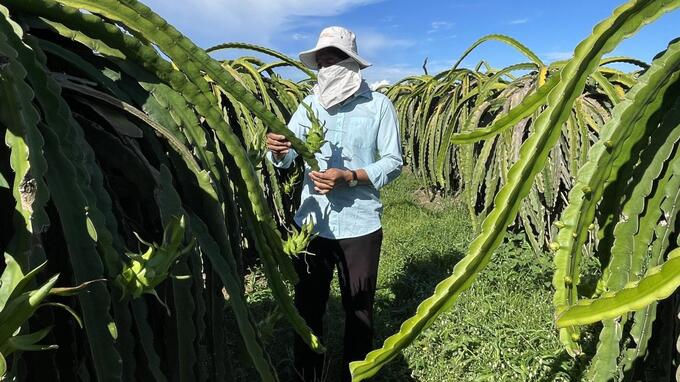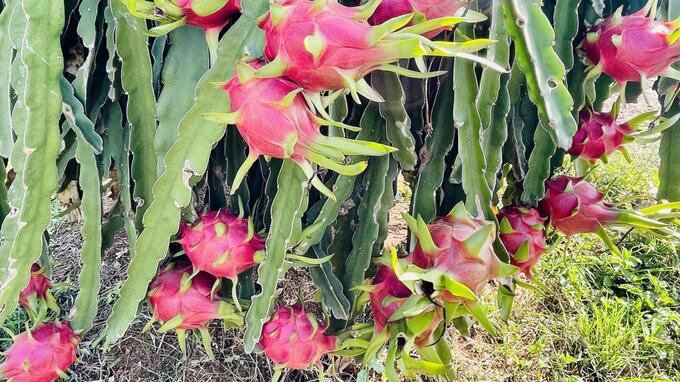
When farmers apply biological control of fake mealybugs, it has positive effects, ensuring that the product is not contaminated with pesticide residues. Photo: KH.
According to Binh Thuan Plantation and Plant Protection Sub-Department, China currently allows official import of 9 fresh fruits from Vietnam, including dragon fruit, with the requirement to have a phytosanitary certificate and not be contaminated with harmful chemicals. regulated pests .
Notably, 3 species of false mealybugs Pseudococcus jackbeardslyei, Phenacoccus solanopsis and Planococcus minor are the objects that China requires strict control on dragon fruit...
Therefore, the application of integrated control measures, in which biological control measures are very important to reduce the use of chemical drugs, increase quality, and maintain productivity to meet the requirements of dragon fruit export. of the Chinese market as well as other markets.

Fake mealybugs are the subject of plant quarantine strictly controlled by the Chinese side. Photo: KH.
Since 2020, the Plant Protection Institute has conducted research on mealybugs that damage dragon fruit and proposed biological control measures. From January to August 2022, Binh Thuan Plant Protection and Cultivation Sub-Department in collaboration with the Plant Protection Institute has built a model of false mealybug control with an area of 1.5ha (0.5ha of basic garden and 1ha business garden) in Phu Nhang village, Ham Hiep commune (Ham Thuan Bac district).
In addition, the Institute and Sub-Department also organized a training course for farmers on detection techniques and measures to prevent fake mealybugs that damage dragon fruit.
According to the farmers, measures are implemented on the model such as cutting off damaged fruit stalks, ineffective shoots, parts heavily damaged by mealybugs, etc. to be destroyed.
Along with that, apply biological measures such as intercropping some colorful flowers such as fake star flowers, and periwinkle... in the dragon fruit garden (one row of flowers is planted in every 3 rows of dragon fruit) in order to create a place. reside and attract natural enemies; proceed to release ladybugs to catch prey, and parasitic wasps to kill fake mealybugs. The model also uses biological products and biological drugs to kill other pests and diseases.
Mr. Truong Van Hong, a farmer participating in the model in Ham Hiep commune, said that the process of preventing fake mealybugs from harming dragon fruit in the direction of biosecurity is simple and easy for farmers to apply. Over time applying the model, he found that the fake mealybugs that harmed dragon fruit were well controlled, limited the use of pesticides, ensured that the products did not have pesticide residues, and the yield was still guaranteed.

The biological model of mealybug control ensures the yield and quality of dragon fruit. Photo: KH.
Visiting the biological-oriented false mealybug control model of the family of Mr. Truong Van Hong, Mr. Le Anh Hao in Ham Hiep commune wished the authorities would continue to guide farmers to replicate the model to improve the quality of the fruit. long is increasing, meeting all export markets.
Mr. Le Huu Nhiem, technical officer (Binh Thuan Plantation and Plant Protection Department) said that over time, the implementation of a model of preventing fake mealybugs by biological struggle has helped dragon fruit gardens to control mealybugs well. harmful fake. Therefore, dragon fruit farmers in the province need to replicate this model for favorable export products.
According to the evaluation of the Plantation and Plant Protection Department of Binh Thuan province, in addition to good control of mealybugs that damage dragon fruit with high prevention efficiency of over 80%, the model also reduces 1 time of chemical spraying/crop. Farmers applying this process will increase their economic efficiency by 25% compared to the previous application of false mealybug control measures.
Binh Thuan agriculture industry and dragon fruit growers are hoping that this model will be replicated in dragon fruit production in the near future.
Binh Thuan is the capital of dragon fruit production of the country. In 2021, the area of dragon fruit in this province is about 33,750ha, with more than 30,000 farmers participating in the production, purchasing, preliminary processing and export of dragon fruit. Every year, dragon fruit trees create regular jobs for 70-80,000 workers. The export value of dragon fruit accounts for a high proportion in the structure of fruit production value.






.png)